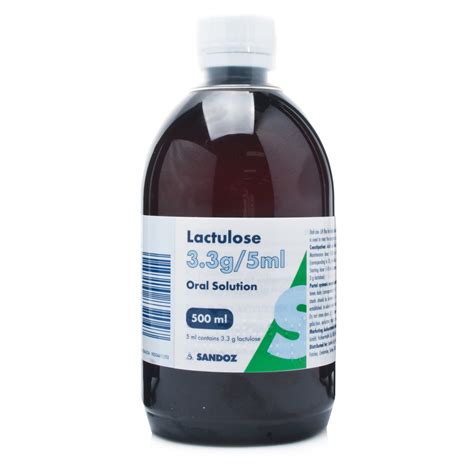Constipation, a common gastrointestinal issue, affects millions of people worldwide, causing discomfort, pain, and disruption to daily life. Among the various treatments available, lactulose stands out as a highly effective and widely prescribed medication for relieving constipation. But what exactly is lactulose, how does it work, and what benefits can it offer to those suffering from constipation? In this comprehensive guide, we will delve into the world of lactulose, exploring its mechanism of action, benefits, potential side effects, and practical tips for incorporating it into your treatment regimen.
Understanding Lactulose
Lactulose is a synthetic disaccharide, composed of fructose and galactose molecules. It is not absorbed in the small intestine and instead reaches the colon, where it is fermented by the colonic bacteria. This fermentation process produces short-chain fatty acids, which decrease the pH of the colonic contents. The decrease in pH stimulates the production of water and electrolytes in the colon, softening the stool and making it easier to pass. Additionally, lactulose increases the amount of water in the stool, further facilitating bowel movements.
Benefits of Lactulose
The primary benefit of lactulose is its ability to provide effective relief from constipation. It works by:
- Softening the Stool: By increasing the water content in the stool, lactulose makes it softer and easier to pass, reducing the strain during bowel movements.
- Stimulating Bowel Movements: The fermentation process and the subsequent production of short-chain fatty acids stimulate the muscles in the intestines to move the stool along, helping to establish a regular bowel movement pattern.
- Promoting the Growth of Beneficial Bacteria: Lactulose acts as a prebiotic, fostering the growth of beneficial bacteria in the gut. A healthy gut microbiome is essential for overall digestive health and can help prevent future episodes of constipation.
Potential Side Effects
While lactulose is generally well-tolerated, it can cause some side effects, especially when first starting the treatment. Common side effects include:
- Gas and Bloating: The fermentation process can lead to the production of gas, causing bloating and discomfort.
- Abdominal Cramps: Some individuals may experience abdominal cramps due to the increased activity in the intestines.
- Diarrhea: In some cases, lactulose can cause diarrhea, especially if the dose is too high.
To minimize these side effects, it is recommended to start with a low dose and gradually increase as needed and under the guidance of a healthcare provider.
Practical Tips for Using Lactulose
To get the most out of lactulose and minimize potential side effects, consider the following tips:
- Start with a Low Dose: Begin with the lowest recommended dose to allow your body to adjust to the medication.
- Gradually Increase the Dose: If necessary, gradually increase the dose under the supervision of a healthcare provider until you find the dose that works best for you.
- Stay Hydrated: Drinking plenty of water is essential when taking lactulose to help the medication work more effectively and reduce the risk of side effects.
- Combine with Dietary Changes: For optimal results, consider combining lactulose with dietary changes, such as increasing fiber intake and eating regular, balanced meals.
- Monitor Your Progress: Keep track of your bowel movements and any side effects. This information will be invaluable in adjusting your treatment plan.
Conclusion
Lactulose offers a safe and effective way to manage constipation, especially for those who have not found relief with other treatments. By understanding how lactulose works, its benefits, and how to incorporate it into your daily routine, you can take the first steps towards finding relief from constipation and improving your overall digestive health. Remember, it’s essential to consult with a healthcare provider before starting any new medication, including lactulose, to discuss the best approach for your specific condition and to minimize potential side effects.
FAQ Section
How long does it take for lactulose to start working?
+Lactulose can begin to work within 24 to 48 hours, but it may take up to 2 weeks for the full effect to be felt. It's essential to be patient and consistent with the treatment.
Can lactulose be used by pregnant or breastfeeding women?
+Lactulose is generally considered safe during pregnancy and breastfeeding. However, it's always best to consult with a healthcare provider before starting any new medication during these periods.
Are there any foods that should be avoided when taking lactulose?
+There are no specific foods that need to be avoided when taking lactulose. However, a balanced diet with adequate fiber can help maximize the effects of the medication.
By addressing the root causes of constipation and fostering a healthier gut environment, lactulose provides a valuable tool in the management of this common condition. Whether you’re seeking immediate relief or a long-term solution, understanding lactulose and how to integrate it into your treatment plan can be a significant step towards a life with fewer disruptions from constipation.



